There are many types of malware today, and rootkit malware is among the most common. Rootkits are also particularly troublesome, as they're designed to remain hidden on your system.
So how can you define a rootkit? What is a rootkit attack? And how can protect against them?
What Is a Rootkit?
A rootkit is a type of malicious software that’s designed to attack computer systems by leveraging advanced intrusion vectors to bypass standard security protocols. Rootkits also use sophisticated obfuscation techniques to hide in plain sight in system kernels.
Usually, rootkit malware is used to spy on system activities, steal data, control vital machine operations, and install other types of malware. This is typically accomplished by obtaining high-level system administrative privileges.
As such, many of them are hard to eliminate. In some cases, a complete reformatting of the hard drive and an OS reinstallation is needed to remove this class of computer worms. In extreme cases, a hardware replacement is the ultimate solution.
Types of Rootkit Malware

There are numerous types of rootkit malware. Here are some of the most common types of rootkits.
1. Firmware Rootkits
The most advanced rootkits are firmware rootkits. This is because they target high-privilege sectors such as the Basic Input/Output System (BIOS) and Unified Extensible Firmware Interface (UEFI) components.
BIOS and UEFI are primary targets because they host vital system components that have beyond Ring 0 privileges. BIOS and UEFI are also responsible for loading all core firmware, software, and hardware systems when the computer is booting.
Related: What Is UEFI And How Does It Keep You More Secure?
Corrupting these system components allows hackers to have greater control over system resources.
2. Hardware Rootkits
Hardware rootkits are designed to target hardware peripheral devices such as Wi-Fi routers, webcams, and hard drives.
They are generally referred to as hardware malware because they are able to control hardware system components, intercept any useful data that goes through them, and send it to hackers.
3. Bootloader Rootkits
Bootloader rootkit targets the Master Boot Record segment in a system. The Bootloader is responsible for starting up the operating system.
It locates where the operating system is stored in the hard drive to allow booting via Random-Access Memory (RAM). By replacing the default bootloader with one created by hackers, attackers can gain access to most system modules.
4. Application Rootkits
Application rootkits are the most common type of rootkit. They target apps in Windows, especially those that are typically used to input sensitive data.
The most targeted apps are usually browsers and native Windows apps such as Microsoft Word and Excel.
How Rootkit Malware Gets Into a System
Rootkit malware usually infects a computer system through various modes.
1. Portable Data Storage Media

Infections via data storage media such as USB flash and external hard drives are among the most common. This is because they are popular, inexpensive, and portable. Because they are regularly used to transfer data between computers, they are frequently targeted in infection campaigns.
In most cases, malware designed to spread via USB drives is able to detect when the device is plugged into a computer. Once this is established, it executes malicious code that embeds itself onto the hard drive. This attack technique helps hackers acquire new sequential victims.
2. Infected Attachments
The other infection vector that helps spread rootkits is infected attachments. In these types of ploys, legitimate-looking emails with malware attachments are sent to targets, usually disguised as urgent notifications. The malware infection sequence begins once the emails are opened, and the attachments downloaded.
If the infection is successful, hackers use rootkits to modify operating system directories and registry keys. They can also intercept sensitive data and communications on the computer, such as chat messages.
Related: How to Spot Unsafe Email Attachments
To remotely control computing functions, intruders use rootkits to open TCP ports in Windows and write firewall exceptions.
3. Downloading Unsigned Applications on Torrent Sites
Another way which helps new rootkit infections spread is through the download of unsigned applications from torrent sites. Because the files are in most cases corrupted, there is usually no way to ascertain their safety.
As such, many of the applications are laden with malware, including rootkits.
How to Prevent and Remove Rootkit Malware
Rootkits are extremely harmful once they get ahold of a machine. Here are some of the ways through which you can prevent rootkit infections.
1. Use Reputable Antivirus Software

Using reputable antivirus software is among the first steps to take when trying to prevent rootkit infections. Among the best antivirus suites for these types of infections are Avast, Kaspersky, Bitdefender, ESET Nod32, and Malwarebytes.
Kaspersky has a fast dedicated tool called Kaspersky TDSSKiller that’s designed to detect and remove the TDSS rootkit family. Scanning usually only takes a few minutes. McAfee also has its standalone RootkitRemover tool that can get rid of Necurs, ZeroAccess, and TDSS rootkits.
2. Avoid Opening Emails from Unknown Sources
Rootkits are sometimes spread through attachments in emails and chat applications. Usually, hackers trick a target into opening an email featuring a dubious offer or urgent notification.
Once the attachment is opened, the infection sequence starts.
Do not download attachments or click links in emails you're not sure about.
3. Update Software
Every once in a while, hackers target outdated applications that are full of bugs. This is one of the main reasons why Windows regularly releases system patches and recommends turning on automatic updates.
As a rule of thumb, sensitive applications such as browsers should be regularly updated because they are gateways to the internet. As such, their security is paramount in protecting the whole operating system.
Related: Understanding Malware: Common Types You Should Know About
The latest releases usually have updated security features such as anti-cryptojackers, pop-up blockers, and anti-fingerprinting mechanisms. Installed antivirus software and firewalls should also be regularly updated.
4. Use Rootkit Detection Scanners
It is best to use a variety of rootkit detection tools to prevent these types of infections. Not all rootkits can be detected using certain antivirus software. Because most rootkits are triggered at the beginning of system processes, scanners that operate when the system is booting are essential.
In this case, the Avast boot-time scanner is among the best for this. It starts scanning for malware and rootkits just before Windows starts and is highly effective in catching them before they hide in system kernels through emulation.
Protect Against Rootkit Viruses
Scanning the system while in safe mode is another trick used to catch most viruses in their inactive form. If this doesn't work, formatting the hard drive and reinstalling the operating system will help.
For advanced protection against rootkits, replacing standard computers with Secured-core computers is advised. They have the latest, most elaborate threat prevention mechanisms.
